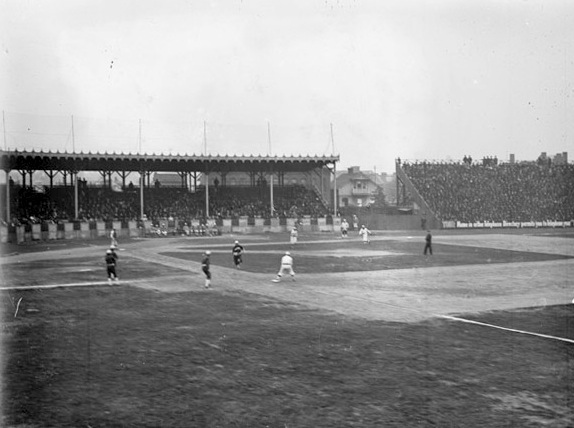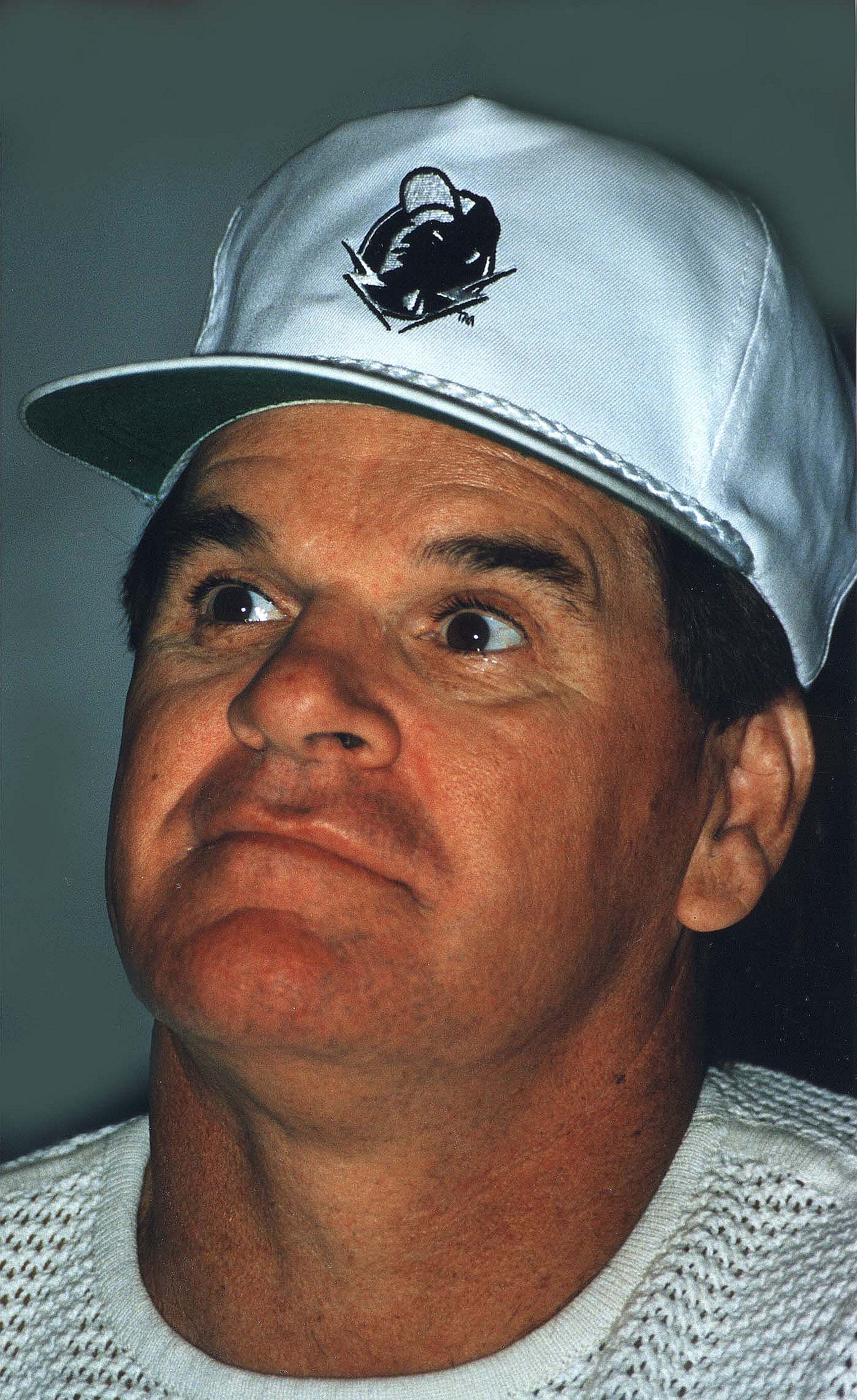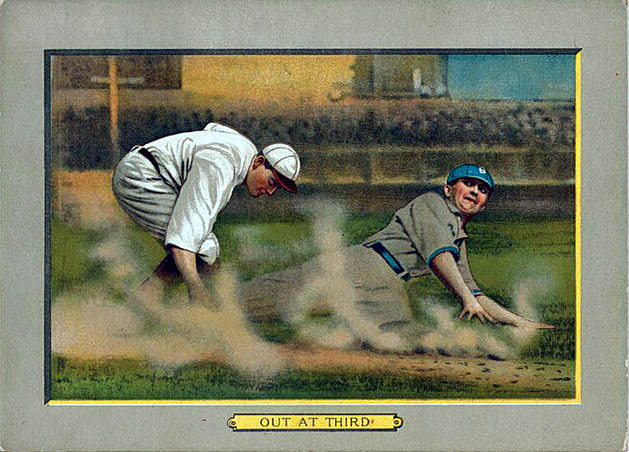|
Clarence Beers
Clarence Scott Beers (December 9, 1918 – December 6, 2002) was an American professional baseball pitcher whose 13-season career included a single game played in the major leagues in as a member of the St. Louis Cardinals. Born in El Dorado, Kansas, Beers batted and threw right-handed, stood tall and weighed . He signed with St. Louis in 1937, but his minor league career was interrupted when he missed the 1938 season and the 1943–1945 campaigns, the latter because of his service in the United States Army Air Forces during World War II. He returned to baseball in , and the following season he led the Double-A Texas League in games won (25) and posted a stellar 2.40 earned run average as a member of the Houston Buffaloes. Beers was 29 years old when he received his only big-league opportunity on May 7, 1948. The Cardinals were trailing the Chicago Cubs at Sportsman's Park 7–4 when Beers was summoned to the mound in the eighth inning to relieve left-hander Ken Johnson ... [...More Info...] [...Related Items...] OR: [Wikipedia] [Google] [Baidu] |
Pitcher
In baseball, the pitcher is the player who throws ("pitches") the baseball from the pitcher's mound toward the catcher to begin each play, with the goal of retiring a batter, who attempts to either make contact with the pitched ball or draw a walk. In the numbering system used to record defensive plays, the pitcher is assigned the number 1. The pitcher is often considered the most important player on the defensive side of the game, and as such is situated at the right end of the defensive spectrum. There are many different types of pitchers, such as the starting pitcher, relief pitcher, middle reliever, lefty specialist, setup man, and the closer. Traditionally, the pitcher also bats. Starting in 1973 with the American League(and later the National League) and spreading to further leagues throughout the 1980s and 1990s, the hitting duties of the pitcher have generally been given over to the position of designated hitter, a cause of some controversy. The Japanese Central Le ... [...More Info...] [...Related Items...] OR: [Wikipedia] [Google] [Baidu] |
Sportsman's Park
Sportsman's Park was the name of several former Major League Baseball ballpark structures in St. Louis, Missouri. All but one of these were located on the same piece of land, at the northwest corner of Grand Boulevard and Dodier Street, on the north side of the city. History Sportsman's Park was the home field of both the St. Louis Browns of the American League, and the St. Louis Cardinals of the National League from 1920 to 1953, when the Browns relocated to Baltimore and were rebranded as the Orioles. The physical street address was 2911 North Grand Boulevard. The ballpark (by then known as Busch Stadium, but still commonly called Sportsman's Park) was also the home to professional football: in , it hosted St. Louis' first NFL team, the All-Stars, and later hosted the St. Louis Cardinals of the National Football League from 1960 (following the team's relocation from Chicago) until 1965, with Busch Memorial Stadium opening its doors in 1966. 1881 structure Baseball was pla ... [...More Info...] [...Related Items...] OR: [Wikipedia] [Google] [Baidu] |
Hank Schenz
Henry Leonard Schenz (April 11, 1919 – May 12, 1988) was an American professional baseball player whose career lasted 14 seasons (1939–1942; 1946–1955), including all or parts of six years in Major League Baseball as a member of the Chicago Cubs (1946–1949), Pittsburgh Pirates (1950–1951) and New York Giants (1951). An infielder, Schenz primarily played second base and was known for his competitive nature and prowess as a bench jockey. The native of New Richmond, Ohio, threw and batted right-handed. He stood tall and weighed . Baseball career Schenz' minor-league apprenticeship was interrupted by three years of World War II service in the United States Navy. Returning to the game in at age 27, he spent most of that year with the Tulsa Oilers of the Double-A Texas League, where he batted .333 with 180 hits and was selected the loop's Most Valuable Player. In September, he was recalled to the parent Cubs and played in six late-season games, with two hits in 11 at bats. ... [...More Info...] [...Related Items...] OR: [Wikipedia] [Google] [Baidu] |
Del Wilber
Delbert Quentin Wilber (February 24, 1919 – July 18, 2002), was an American professional baseball player, manager, coach and scout. A catcher, he appeared in 299 Major League games for the St. Louis Cardinals (1946–49), Philadelphia Phillies (1951–52) and Boston Red Sox (1952–54). The native of Lincoln Park, Michigan, threw and batted right-handed. He stood tall and weighed . Catcher with three MLB clubs Wilber signed with the American League St. Louis Browns in 1938, but was acquired by the Cardinals in 1940 and played in their extensive farm system until the outbreak of World War II; he missed the 1942–45 seasons while serving in the United States Army Air Force, where he attained the rank of captain. In , he resumed his baseball career and made his Major League debut, appearing in four games before being sent to the Triple-A Columbus Red Birds. He did not appear in the 1946 World Series. Wilber played in 51 games for the 1947 Cardinals and 27 more in 1948, ... [...More Info...] [...Related Items...] OR: [Wikipedia] [Google] [Baidu] |
Catcher
Catcher is a Baseball positions, position in baseball and softball. When a Batter (baseball), batter takes their at bat, turn to hit, the catcher crouches behind home plate, in front of the (home plate, home) Umpire (baseball), umpire, and receives the ball from the pitcher. In addition to this primary duty, the catcher is also called upon to master many other skills in order to field the position well. The role of the catcher is similar to that of the wicket-keeper in cricket. Positioned behind home plate and facing toward the outfield, the catcher can see the whole field, and is therefore in the best position to direct and lead the other players in a defensive play. The catcher typically calls for pitches using hand signals. The calls are based on the pitcher's mechanics and strengths, as well as the Batting (baseball), batter's tendencies and weaknesses. Essentially, the catcher controls what happens during the game when the ball is not "in play". Foul tips, bouncing balls in ... [...More Info...] [...Related Items...] OR: [Wikipedia] [Google] [Baidu] |
Error (baseball)
In baseball statistics, an error is an act, in the judgment of the official scorer, of a fielder misplaying a ball in a manner that allows a batter or baserunner to advance one or more bases or allows a plate appearance to continue after the batter should have been put out. The term ''error'' is sometimes used to refer to the play during which an error was committed. Relationship to other statistical categories An error does not count as a hit but still counts as an at bat for the batter unless, in the scorer's judgment, the batter would have reached first base safely but one or more of the additional bases reached was the result of the fielder's mistake. In that case, the play will be scored both as a hit (for the number of bases the fielders should have limited the batter to) ''and'' an error. However, if a batter is judged to have reached base solely because of a fielder's mistake, it is scored as a "reach on error (ROE)," and treated the same as if the batter had been put o ... [...More Info...] [...Related Items...] OR: [Wikipedia] [Google] [Baidu] |
Passed Ball
In baseball, a catcher is charged with a passed ball when he fails to hold or control a legally pitched ball that, with ordinary effort, should have been maintained under his control, and, as a result of this loss of control, the batter or a runner on base advances. A runner who advances due to a passed ball is not credited with a stolen base unless he breaks for the base before the pitcher begins his delivery. History A passed ball may be scored when a base runner reaches the next base on a bobble or missed catch by the catcher, or when the batter–runner reaches first base on an uncaught strike three (''see also'' Strikeout). A closely related statistic is the wild pitch. As with many baseball statistics, whether a pitch that gets away from a catcher is a passed ball or wild pitch is at the discretion of the official scorer. Typically, pitches that are deemed to be ordinarily catchable by the catcher, but are not, are ruled passed balls; pitches that get by the catcher that ... [...More Info...] [...Related Items...] OR: [Wikipedia] [Google] [Baidu] |
Intentional Walk
In baseball, an intentional base on balls, usually referred to as an intentional walk and denoted in baseball scorekeeping by ''IBB'', is a walk issued to a batter by a pitcher with the intent of removing the batter's opportunity to swing at the pitched ball. A pitch that is intentionally thrown far outside the strike zone for this purpose is referred to as an ''intentional ball''. Beginning with the 2017 season, Major League Baseball has removed the requirement to throw four intentional balls. In MLB and in amateur baseball, such as high school and college games, and in most levels of Little League Baseball, the manager of the team on the field now simply asks the plate umpire to let the batter go to first base. Strategy The purpose of an intentional walk is to bypass the current batter in order to face the following batter, whom the defensive team expects to be easier to put out. The risk to the fielding team issuing an intentional walk is that they turn the batter into a ba ... [...More Info...] [...Related Items...] OR: [Wikipedia] [Google] [Baidu] |
Double (baseball)
In baseball, a double is the act of a batter striking the pitched ball and safely reaching second base without being called out by the umpire, without the benefit of a fielder's misplay (see error) or another runner being put out on a fielder's choice. A double is a type of hit (the others being the single, triple and home run) and is sometimes called a "two-bagger" or "two-base hit". For statistical and scorekeeping purposes it is denoted by 2B. Description Typically, a double is a well-hit ball into the outfield that finds the "gap" between the center fielder and one of the corner outfielders, bounces off the outfield wall and down into the field of play, or is hit up one of the two foul lines. To hit many doubles, a batter must have decent hitting skill and power; it also helps to run well enough to beat an outfield throw. Doubles typically drive in runs from third base, second base, and even from first base at times. When total bases and slugging percentages are ca ... [...More Info...] [...Related Items...] OR: [Wikipedia] [Google] [Baidu] |
Wild Pitch
In baseball, a wild pitch (WP) is charged against a pitcher when his pitch is too high, too short, or too wide of home plate for the catcher to control with ordinary effort, thereby allowing a baserunner, or the batter (on an uncaught third strike), to advance. A wild pitch usually passes the catcher behind home plate, often allowing runners on base an easy chance to advance while the catcher chases the ball down. Sometimes the catcher may block a pitch, and the ball may be nearby, but the catcher has trouble finding the ball, allowing runners to advance. A closely related statistic is the passed ball. As with many baseball statistics, whether a pitch that gets away from a catcher is counted as a wild pitch or a passed ball is at the discretion of the official scorer. The benefit of the doubt is usually given to the catcher if there is uncertainty; therefore, most of these situations are scored as wild pitches. If the pitch was so low as to touch the ground, or so high that the ... [...More Info...] [...Related Items...] OR: [Wikipedia] [Google] [Baidu] |
Single (baseball)
In baseball, a single is the most common type of base hit, accomplished through the act of a batter safely reaching first base by hitting a fair ball (thus becoming a runner) and getting to first base before a fielder puts him out. As an exception, a batter-runner reaching first base safely is not credited with a single when an infielder attempts to put out another runner on the first play; this is one type of a fielder's choice. Also, a batter-runner reaching first base on a play due to a fielder's error trying to put him out at first base or another runner out (as a fielder's choice) is not credited with a single. On a single hit to the outfield, any runners on second base or third base normally score, and sometimes the runner from first base is able to advance to third base. Depending on the location of the hit, a quick recovery by the outfielder can prevent such an advance or create a play on the advancing runner. Hitters who focus on hitting singles rather than doubles ... [...More Info...] [...Related Items...] OR: [Wikipedia] [Google] [Baidu] |
Out (baseball)
In baseball, an out occurs when the umpire rules a batter or baserunner out. When a batter or runner is out, they lose their ability to score a run and must return to the dugout until their next turn at bat. When three outs are recorded in a half-inning, the batting team's turn expires. To signal an out, an umpire generally makes a fist with one hand, and then flexes that arm either upward, particularly on pop flies, or forward, particularly on routine plays at first base. Home plate umpires often use a "punch-out" motion to signal a called strikeout. Ways of making outs * The most common ways batters or runners are put out are when: ** The batter strikes out (they make three batting mistakes, known as ''strikes'', without hitting the ball into fair territory); ** The batter flies out (they hit the ball and it is caught before landing); ** a baserunner is tagged out (they are touched by the ball, held in an opponent's hand, while not on a base); ** a baserunner is forced ... [...More Info...] [...Related Items...] OR: [Wikipedia] [Google] [Baidu] |


.jpg)

.jpg)


.jpg)

